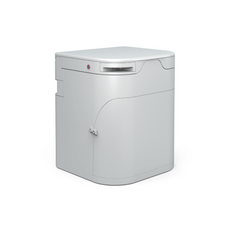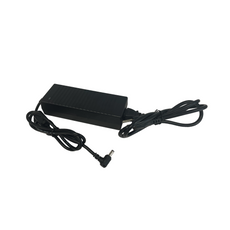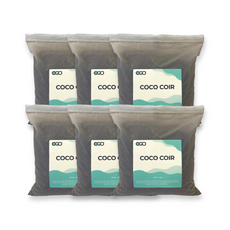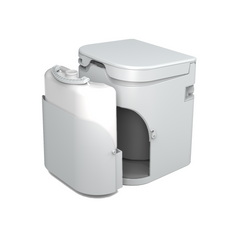
Dual-Flush Toilet Buyers Guide
About a third of your home's water use comes from your toilet. Dual flush toilets can save 60 to 70% more water than toilets manufactured before 1994. Unfortunately, many homes still use older toilets that are still wasting an average of over 70 liters of water per person per day. Homes still using old toilets can expect to save 8,000 gallons (30,000 liters) of water if they flush their toilet ten times per day.
How Does a Dual Flush Toilet Work?
Dual flush toilets do precisely what their name implies; they have two options for flushing. High volume flushes are ideal for solid waste, while low volume flushes should be used for liquid waste. This dual flush system makes their average flushing volume low enough to meet high-efficiency or ultra-high efficiency standards.
Dual Flush Toilet - By the Numbers

How Much Water Does a Dual Flush Toilet Use?
Toilets made before 1980 use 5 to 7 gallons of water per flush, on average, with some using 8 gallons per flush or more. Toilets made between 1980 and 1992 generally use 3.5 gallons of water per flush. In 1994, Federal law was enacted to increase water efficiency, which stipulated that toilets must use an average of 1.6 gallons per flush or less. Currently, the average flush volume of modern toilets is roughly 1.1 gallons per flush.

Which Button Do You Push on a Toilet?
Dual flush toilets come equipped with two flushing options, a lever or a dual button. Most toilets will include instructions, visible directly on the toilet or in the owner's manual. When in doubt, you can follow these guidelines. For toilets with push buttons on the top lid, the smaller of the two buttons are for flushing solely water waste. The larger button is ideal for high volume waste, including toilet paper. If your toilet has a dual function lever, upward motions are for low volume flushes, and pushing the lever down is for high volume flushes, including toilet paper.

What Toilet Bowl Is Right For You?
With thousands of toilet models available on the market today, it's no wonder making what seems like a simple choice can be unnecessarily complicated. So we're going to make it easy for you: when selecting your next toilet. Here's what you'll want to consider:
What Is the Difference Between Standard Height and Comfort Height Toilets?
Short or tall, the trend these days is to have a slightly higher bowl. Standard toilet heights are around 14 to 15 inches off the ground. Comfort height toilets are 16 to 18 inches off the ground for ease of getting up and down.
Are Lined Toilet Tanks Necessary?
Lined toilet tanks prevent condensation in warm summer months with an insulated tank. You might also be able to prevent condensation if your home is air-conditioned, has dry air, and a water source that isn't too cold.
What Makes a Toilet Seat Comfortable?
It's never a bad idea to 'try before you buy', but in this case, you'll have to limit the test drive to just sitting on the bowl. You might want to consider the finishes of the seat as well, like plastic or wood.
The Shape of the Toilet Bowl
Round, oval, square? While this may seem trivial, an elongated bowl is typically a more hygienic choice.
Is the Flush in an Easy to Reach Place?
You'll want to figure out whether you want a top, left, right, side-mounted flush that works well with your bathroom configuration.
What About That Lid?
Soft-close lids are increasingly the norm for most bowls.
Is a One-Piece Toilet Better Than a Two-Piece?
The two-piece is the most common option and also typically less money. One-piece toilets are easier to clean, have smaller water tanks, and generally cost a bit more money.
What Toilet Has the Best Flushing Power?
There's still some debate about which type of flushing action is best - whether it's gravity or pressure-assisted flushes. Traditionally, the pressure-assisted method provides better performance. Still, nowadays, gravity flushes come pretty close.

Check the Label
Ultra-Low Flush Toilets (ULF) Labeled Toilets
Ulta low flush toilets follow Federal guidelines. Toilets bearing this logo are certified to use 1.6 gallons per flush or less.
High-Efficiency Toilets (HET) Labeled Toilets
Dual flush toilets are a type of high-efficiency toilet, meaning most on the market will utilize 1.1 gallons per flush or less.
WaterSense Labeled Toilets
Watersense and MaP (Maximum Performance Testing Program) is a voluntary toilet certification which is performed by independent labs that rigorously test for performance and efficiency.
Maximum Performance Testing (MaP) Labeled Toilets
MaP grades water usage and flushing performance of each toilet. For toilets to fit the bill under Watersense or MaP, they'll need to score above 350g of waste per flush.
Considerations When Installing a Toilet
The Rough-in is the distance between the wall behind the toilet and the center of the outlet pipe. You'll want to make sure the model you choose has enough rough-in space to fit the toilet without leaving too much of a gap behind the toilet. Size of outgoing toilet versus incoming toilet - there may be modifications needed to the floor if the incoming model has a smaller footprint.
Alternative Toilet Options
Low Flow Toilet with Single Flush
If using 6-liter flushes, a dual-flush will outperform it by about 26%. However, Single Flush UHET (Ultra High-Efficiency Toilet) can reduce a single flush down to as low as 3 liters/flush. So while a dual-flush might mean efficiency at first glance, don't discount all single flush toilets, especially Ultra High-Efficiency models.
Composting Toilet
If you're living that tiny home life or don't want to rely on water/sewage, this is something you'll want to look into. You'll also want to check regulations in your area around what's permitted - in many cases, these toilets are intended for mobile structures or remote cabins.
Already Buy a Toilet, but It Doesn't Fit the Bill?
Don't despair; retrofit or conversion kits allow you to turn a single flush toilet into a dual-flush, which even works for older model toilets. Keep in mind, these don't offer the same efficiencies as a dual-flush toilet and can be a pain to install, even for experienced plumbers.
Disclaimer: This article does not constitute a product endorsement however Rise does reserve the right to recommend relevant products based on the articles content to provide a more comprehensive experience for the reader.Last Modified: 2023-11-03T12:55:06+0000
Article by:
Rise
At Rise, we strive to make sustainable home improvement easy and accessible for everyone. Whether you're building or renovating, our thoroughly vetted building products will help you reduce your carbon footprint, lower energy costs, and create a more sustainable living or working environment.




